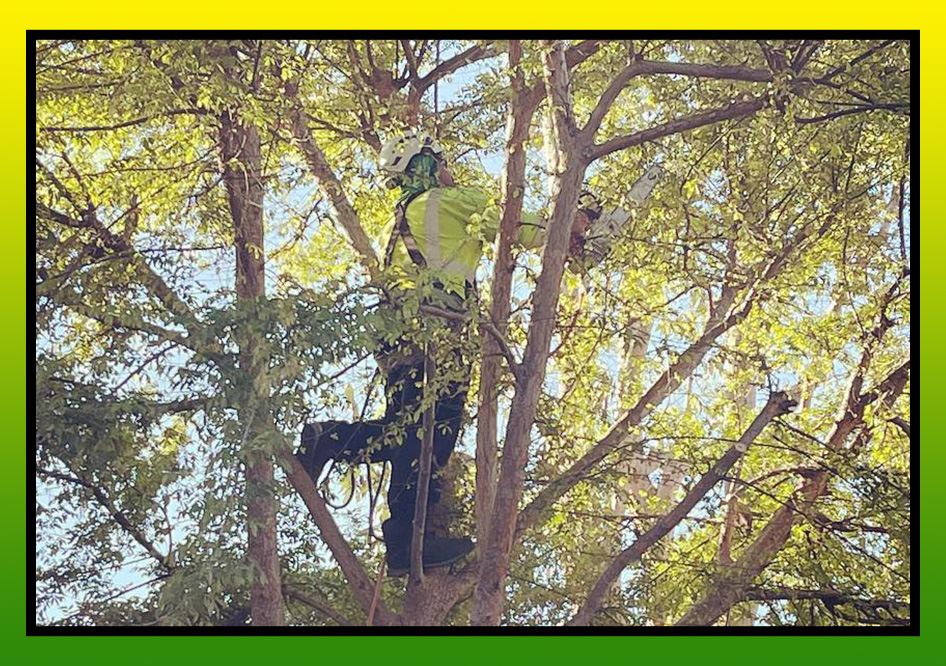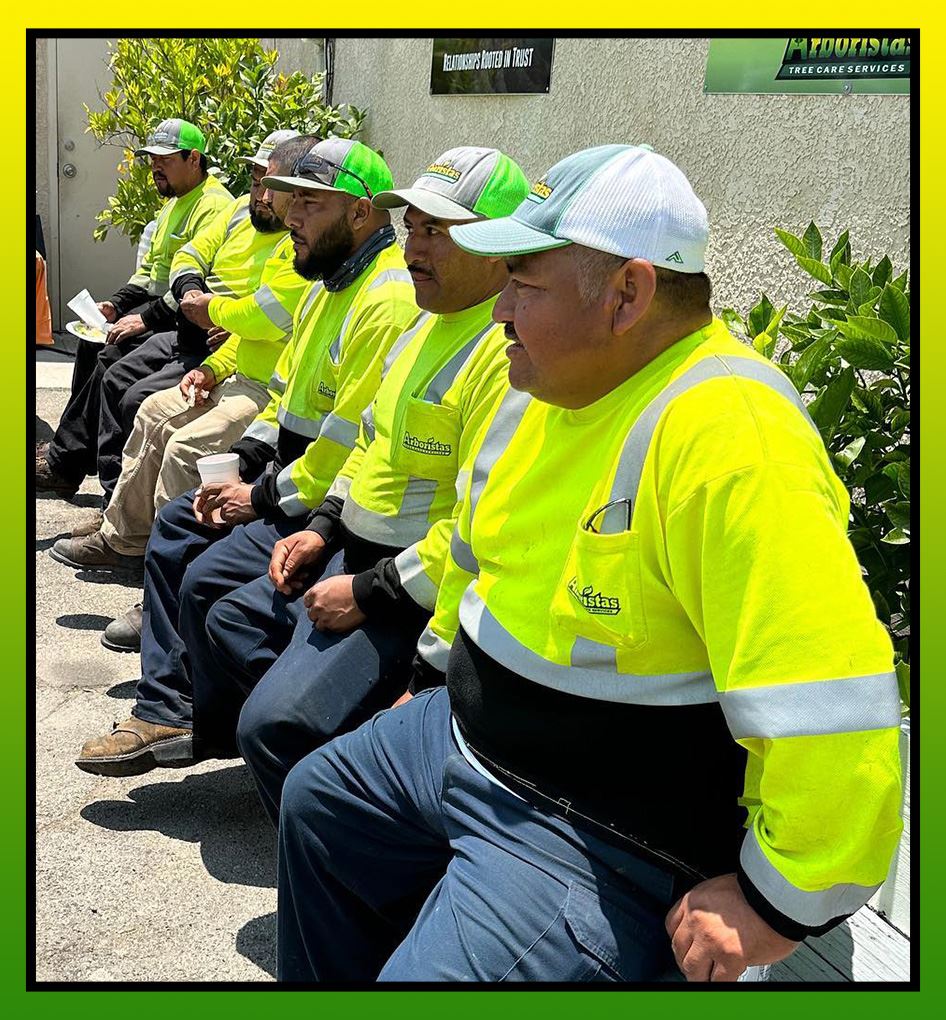A member of our team will be in touch shortly to confirm your contact details or address questions you may have.

Root Collar Excavation in Santa Clarita
Residential & Commercial Landscaping & Tree Care in Los Angeles & Ventura Counties
Buried root collars are one of the most common tree health issues we correct on a regular basis for clients in Los Angeles County, Orange County, Riverside County and the counties of Inland Empire, Antelope Valley, Kern, Ventura and Santa Barbara.
Root collars are buried through various means such planting the tree or shrub too deep, grading, during cultivation at the nursery, and our favorite, the infamous mulch volcano. The mulch volcano is perhaps the most common form of a buried root collar. It is the term used to refer to mulch, dirt, or other debris piled high around the base of a tree or shrub, often for decorative purposes.
Regardless of whether the root collar is buried due to a mulch volcano, grading, or some other reason, it is very bad for a tree or shrub for the following reasons:
- It keeps the trunk moist. Trunks are designed to grow above ground and have not adapted the ability to withstand constant moisture. Only roots can withstand constant moisture.
- The constant moisture causes damage to the cells of the trunk, usually through suffocation.
- As the cells become damaged, they are unable to perform critical functions.
- In addition, roots will grow in the soil or mulch around the trunk and begin girdling. Girdling roots will slowly kill the tree/shrub by inhibiting the exchange of water, nutrients, and photosynthate (food) between the canopy towards the roots.
- As cell functionality diminishes and as roots girdle the tree, the plant declines in health due to lack of nutrients, water, gas exchange, etc.
- As the tree or shrub declines in health, it becomes more susceptible to attack from insects, diseases, and harmful fungi, which greatly compound the existing health issues.
The good news is that this is a problem we can usually fix. To do so, we carefully excavate the root collar using an Air Spade and prune any problematic roots. This assumes this issue has not advanced to the point where it is irreversible, or it does not make financial sense to perform the necessary service. They key is to cause minimal damage to the root system and clear all mulch, dirt, roots, etc away from the trunk.
If you have trees or shrubs with buried root collars or mulch volcanoes, do not wait. This problem only gets worse and harder to fix with time. We would love to send one of our ISA Certified Arborists out to meet with you, evaluate your mulch volcanoes, and provide a free proposal on how to proceed.
Root Collar Excavation Service Areas:
Los Angeles County, Orange County, Riverside County and the counties of Inland Empire, Antelope Valley, Kern, Ventura and Santa Barbara.
Need Us Now? Let’s Talk. (844) 551-7133
Why Choose Arboristas?
Serving Santa Clarita, CA Since 2017
-
Free Estimates Available
-
Customer Care Focused
-
Honest & Transparent
-
Full Landscaping Services
-
Licensed & Insured
-
Emergency Services Available

Our FAQ
Have questions? We are here to help. Still have questions or can't find the answer you need? Give us a call at 844-551-7133 today!
-
What does “stump grinding” mean?Stump grinding is the removal of the tree trunk down to 7″ to 8″ below the soil’s surface and the removal of any visible or surface roots which is common with Cottonwoods and Oaks. When you consider tree and stump removal, you have to think about how deep the root system goes into the ground. For sure, your best option is to have our team of professionals come out to handle your problem. Arboristas has state-of-the-art equipment designed specifically for these situations, and we can answer all questions and concerns you might have, and no job is too big. Our fully insured team can plan, schedule, manage and execute the safe and tidy removal of multiple stumps either pre-construction or old stumps without damaging the existing landscape. We take great pride in our work and can ensure each and every job is done with care not to damage any existing features and in a timely manner. We are happy to provide estimates before starting any work.
-
Why do you remove the tree?As Arborists, our goal is always to save the tree first, after we have exhausted all of our resources, removal is our last alternative. As Arborists, we are here to preserve the trees and if it is determined it is best to remove a tree, there has to be a very strong why As always, we will give you our expert advice based on our years of experience. We want to remove it if the tree is posing a safety hazard, for instance if the tree is leaning and is threatening coming down on people, vehicles, a house or other building. If the tree is creating trip hazards we will evaluate if a root prune is possible before we recommend removal. Obviously there is not one answer for all situations, at Arboristas, we do our best to preserve your trees.
-
Why would you prune a tree?Pruning a tree is for the tree’s health. Removing specific branches or stems can benefit the whole tree. Pruning stimulates new growth and removes any crossover branches that if not taken care of could eventually fuse together. Pruning is also recommended to remove any deadwood or branches in the canopy to prevent them from falling onto people or structures. Pruning stimulates new growth and removes any crossover branches that if not taken care of could eventually fuse together. Pruning is also recommended to remove any deadwood or branches in the canopy to prevent them from falling onto people or structures. Remove dead, damaged and diseased branches also helps prevent insect & decay organisms from entering the tree. Thinning a dense canopy on a tree will increase air and sunlight, resulting in fewer disease problems. A tree also needs to be pruned early in it’s development to make sure it’s structurally sound in the future. Many people think that young trees don’t require any pruning because the tree is young, but it’s the complete opposite. If you want to have a good tree in the future you want to start training it while it’s young removing cross branches and structuring the crown.
-
What’s the best time of the season to fertilize?Trees require nutrients to live and thrive. A fertilization program is used to maintain trees and shrubs in a vigorous condition and to increase their resistance to injury from diseases and insects. Most trees experience a single flush of growth during spring followed by slower growth throughout the summer and fall. Because of this single flush of growth, late winter or early spring is ideal. When the tree is getting ready to leaf out and grow, this is when you want the roots to absorb the good fertilizer and take it to the crown of the tree. The best indicator of whether fertilization is necessary is a soil test. Remember that plant nutrition is a balancing act and that too much fertilizer, as well as too little, can negatively affect the growth and well being of your trees and lawn. The correct amount will keep trees healthy and enhance landscape beauty.
-
Can I make my tree smaller?Yes, however, its dependent on the species. For instance, the pine species don’t come back as quickly as other species do. We ask that you consult us so our experts can evaluate the tree’s health, age and species to give you an accurate idea of what can be done to reduce the size of your tree. To get further details on your specific tree, contact us.
-
When is the best time to prune trees?Most people think that winter is the best time to prune trees, however, that depends on the species of the tree and the result that you want. For instance, any tree that blooms in the spring or summer, you may want wait until the tree is dormant. If it is cleaning it up, or as we call it, structural pruning, this can be determined with further information. We ask that you call us and make an appointment for a free estimate.